The Collapsible Fuel Tank Market is estimated to be valued at USD 1.8 billion in 2025 and is projected to reach USD 4.1 billion by 2035, registering a compound annual growth rate (CAGR) of 8.6% over the forecast period.
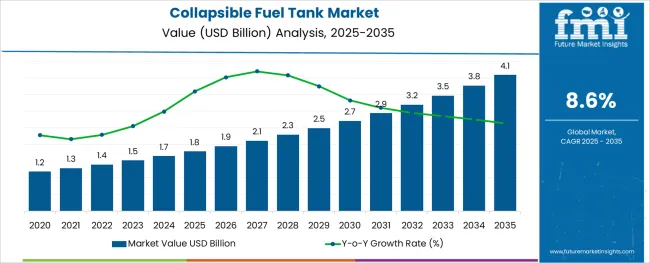
The collapsible fuel tank market is expanding steadily, driven by increasing demand for portable and flexible fuel storage solutions across multiple industries. Growing mechanization in sectors such as agriculture, construction, and military has heightened the need for efficient fuel transport and storage options that can adapt to various environments.
The lightweight and space-saving nature of collapsible tanks has made them attractive alternatives to rigid fuel tanks. Advances in material science have enabled the development of durable, leak-resistant fabrics that ensure safety and longevity under harsh conditions.
Regulatory emphasis on fuel storage safety and environmental protection has also supported market adoption. Future growth is expected to be boosted by expanding end-use applications and innovations in tank capacity and material properties. Segmental growth is expected to be driven by tanks with a capacity of 25 to 100 gallons, polyurethane fabric material for its durability, and agriculture as a key end-use sector.
The market is segmented by Capacity, Fabric Material, and End Use and region. By Capacity, the market is divided into 25 to 100 gallon, 3000 gallon, 10,000 gallon, 50,000 gallon, and 200,000 gallon. In terms of Fabric Material, the market is classified into Polyurethane and Composite Material.
Based on End Use, the market is segmented into Agriculture, Mining, Military Application, Commercial, and Others. Regionally, the market is classified into North America, Latin America, Western Europe, Eastern Europe, Balkan & Baltic Countries, Russia & Belarus, Central Asia, East Asia, South Asia & Pacific, and the Middle East & Africa.
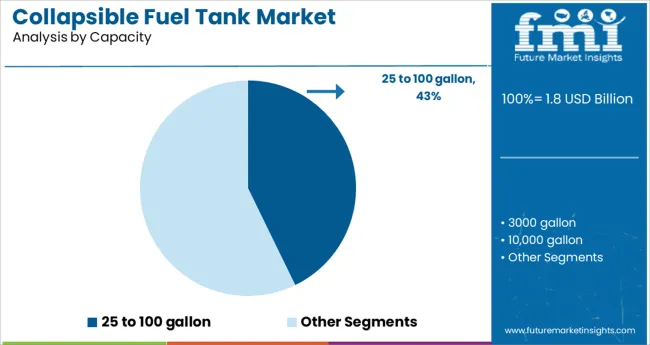
The 25 to 100 gallon capacity segment is projected to hold 42.8% of the collapsible fuel tank market revenue in 2025, making it the leading capacity range. This segment is favored for offering a practical balance between fuel volume and portability, ideal for applications requiring moderate fuel storage without sacrificing flexibility.
It caters well to agricultural machinery, construction equipment, and emergency fuel supply needs where space and weight constraints are critical. The manageable size allows for easier transport and setup, facilitating quick deployment in remote or off-grid locations.
As industries prioritize operational efficiency and mobility, tanks within this capacity range are expected to remain the preferred choice.

The polyurethane fabric material segment is expected to contribute 57.3% of the market revenue in 2025, securing its position as the dominant fabric type. Polyurethane is preferred due to its excellent resistance to abrasion, chemicals, and UV exposure, making it highly suitable for harsh outdoor environments.
Its flexibility and strength ensure the tank can withstand repeated folding and unfolding without damage, enhancing durability and lifespan. Furthermore, polyurethane’s impermeability minimizes fuel vapor loss and leakage, ensuring safety and environmental compliance.
These properties have made polyurethane the fabric of choice for manufacturers and end users seeking reliable and long-lasting collapsible fuel tanks.
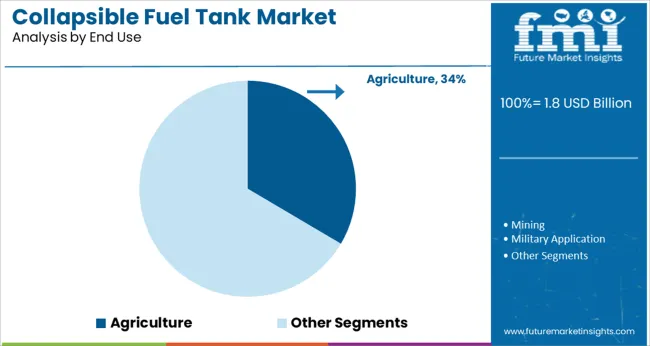
The agriculture segment is projected to hold 33.5% of the collapsible fuel tank market revenue in 2025, establishing itself as the leading end-use industry. Growth in this segment has been supported by the increasing mechanization of farming operations and the need for efficient fuel storage solutions on farms and in remote agricultural areas.
Collapsible fuel tanks provide the portability and adaptability required for refueling tractors, harvesters, and irrigation pumps across diverse terrains. Seasonal farming activities also demand flexible fuel supply options to ensure uninterrupted operations.
The agricultural sector’s focus on reducing downtime and enhancing fuel logistics has contributed significantly to the segment’s growth. As precision farming and sustainable agriculture practices expand, the demand for collapsible fuel tanks in this sector is expected to continue rising.
Collapsible fuel tanks are gaining huge popularity across the various industries such as oil & gas, mining, agriculture, and industries among others, owing to their favorable attributes such as easy instal, bulk storage, high durability, resistance to temperature fluctuation & moisture, others.
All these characteristics make these tanks the most suitable option for fuel storage purposes in remote areas. Thus, these fuel bladders are extensively being used across the military sector for applications such as military oil & fuel storage, military pumping systems, and others in outskirts areas.
Hence, increasing remote military training, weapon testing, surveillance, and defense activities across diverse countries such as China, the USA, India, Russia, Israel, and others are estimated to augment the sales of collapsible fuel tanks in the market.
In addition to this, collapsible fuel tanks are also finding numerous applications for disaster relief fuel supply purposes, owing to their high portability and ease of installation for fuel storage purposes. Hence, increasing floods, landslides, forest fires, earthquakes, and others worldwide is expected to create lucrative opportunities for growth in the global market.
Increasing implementation of stringent regulations regarding the use of plastics such as polyethylene, due to the rising environmental concerns across North America, Asia Pacific, and Europe is estimated to hider the sales of collapsible fuel tanks across the polyethylene segment.
Also, inability to install on irregular surfaces, high risk of puncture, and safety issues associated with the collapsible fuel tanks are the factor hampering the growth in the global market.
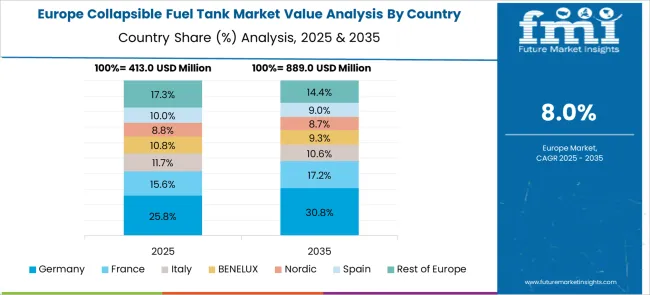
Future Market Insights reveals that Europe is anticipated to emerge as the most remunerative market for collapsible fuel tanks between 2025 and 2035.
Collapsible fuel tanks are increasingly being used in airplanes and other aerial vehicles, owing to their excellent flexibility, high durability, and the ability to fit in tight spaces. This, in addition to increasing adoption across mining activities in remote areas is augmenting the demand for flexible & portable fuel storage solutions.
Hence, leading players in the market are aiming at mergers and acquisitions for expanding their production capacity to capitalize on the surging demand. For instance, in 2020, ContiTech AG, a German manufacturer of intelligent components made of rubber, plastic, metal, and fabric announced acquiring an Italian company, Merlett Group to expand its expertise in developing materials for handling fuels and other industrial fluids.
The acquisition assisted the company to replenish its resources and optimize technology & production. Such developments are estimated to favor the growth in the Europe market.
As per FMI, Asia Pacific excluding Japan is estimated to project robust growth in the global collapsible fuel tank market over the forecast period 2025-2035.
Governments of several countries are emphasizing on investing large sums of money for launching novel oil and gas exploration activities to cater to the accelerating demand for petroleum products. For instance, according to a report by the India Brand Equity Foundation, the Indian Government announced investing nearly USD 2,860 Million in the oil & gas sector to drill over 120 oil exploration well and double the production of natural gas by 2025.
As these exploration activities are undertaken in remote areas, temporary bulk storage solutions such as collapsible fuel tanks are increasingly being used to store the fuel for heavy drilling and exploration machineries. This is anticipated to augment the demand for collapsible fuel tanks in the Asia Pacific excluding Japan market.
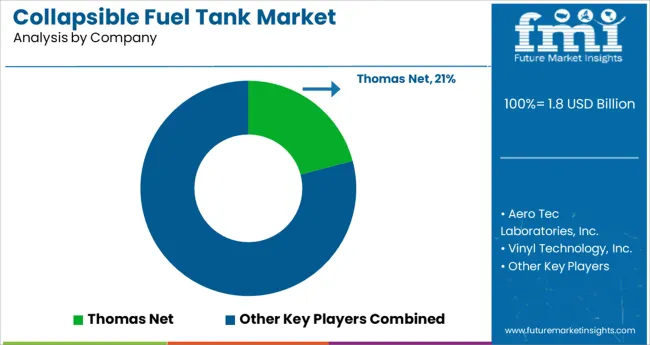
Some of the leading players in the collapsible fuel tanks market are Thomas Net, Aero Tec Laboratories, Inc., Vinyl Technology, Inc., ContiTech AG, SEI Industries, MPC Containment, Amfuel, SPC “Polytechnika” LLC, and others.
Attributed to the presence of such high number of participants and increasing collaboration, acquisition, and mergers, the market is highly competitive.
| Report Attribute | Details |
|---|---|
| Growth Rate | CAGR of 8.6% from 2025 to 2035 |
| Base Year for Estimation | 2024 |
| Historical Data | 2020 to 2024 |
| Forecast Period | 2025 to 2035 |
| Quantitative Units | Revenue in billion, Volume in Kilotons and CAGR from 2025 to 2035 |
| Report Coverage | Revenue Forecast, Volume Forecast, Company Ranking, Competitive Landscape, Growth Factors, Trends and Pricing Analysis |
| Segments Covered | Capacity, Fabric Material, End Use, Region |
| Countries Covered | North America; Latin America; Western Europe; Eastern Europe; APEJ; Japan; Middle East and Africa |
| Key Companies Profiled | Thomas Net; Aero Tec Laboratories, Inc.; Vinyl Technology, Inc.; ContiTech AG; SEI Industries; MPC Containment; Amfuel; SPC “Polytechnika” LLC; Others |
| Customization | Available Upon Request |
The global collapsible fuel tank market is estimated to be valued at USD 1.8 billion in 2025.
It is projected to reach USD 4.1 billion by 2035.
The market is expected to grow at a 8.6% CAGR between 2025 and 2035.
The key product types are 25 to 100 gallon, 3000 gallon, 10,000 gallon, 50,000 gallon and 200,000 gallon.
polyurethane segment is expected to dominate with a 57.3% industry share in 2025.






Full Research Suite comprises of:
Market outlook & trends analysis
Interviews & case studies
Strategic recommendations
Vendor profiles & capabilities analysis
5-year forecasts
8 regions and 60+ country-level data splits
Market segment data splits
12 months of continuous data updates
DELIVERED AS:
PDF EXCEL ONLINE
Collapsible Rigid Containers Market Size and Share Forecast Outlook 2025 to 2035
Collapsible Metal Tubes Market Size and Share Forecast Outlook 2025 to 2035
Collapsible Gates Market Size and Share Forecast Outlook 2025 to 2035
Collapsible Water Bottle Market Size and Share Forecast Outlook 2025 to 2035
Collapsible Wardrobe Market Size and Share Forecast Outlook 2025 to 2035
Collapsible Sleeve Containers Market Growth-Forecast 2025 to 2035
Industry Share Analysis for Collapsible Water Bottle Companies
Competitive Landscape of Collapsible Rigid Containers Providers
Collapsible Jerry Can Market Growth - Size & Forecast 2024 to 2034
Collapsible Food Packaging Containers Market
Collapsible Aluminium Tube Market
Foldable And Collapsible Pallets Market Size and Share Forecast Outlook 2025 to 2035
Fuel rail for CNG Systems Market Size and Share Forecast Outlook 2025 to 2035
Fuel Capacitance Test Equipment Market Size and Share Forecast Outlook 2025 to 2035
Fuel Gas Heater Market Size and Share Forecast Outlook 2025 to 2035
Fuel Management Software Market Size and Share Forecast Outlook 2025 to 2035
Fuel Cell Powertrain Market Size and Share Forecast Outlook 2025 to 2035
Fuel Cell UAV Market Size and Share Forecast Outlook 2025 to 2035
Fuel Cell Stack Market Size and Share Forecast Outlook 2025 to 2035
Fuel Cell Electric Vehicle Market Size and Share Forecast Outlook 2025 to 2035

Thank you!
You will receive an email from our Business Development Manager. Please be sure to check your SPAM/JUNK folder too.
Chat With
MaRIA